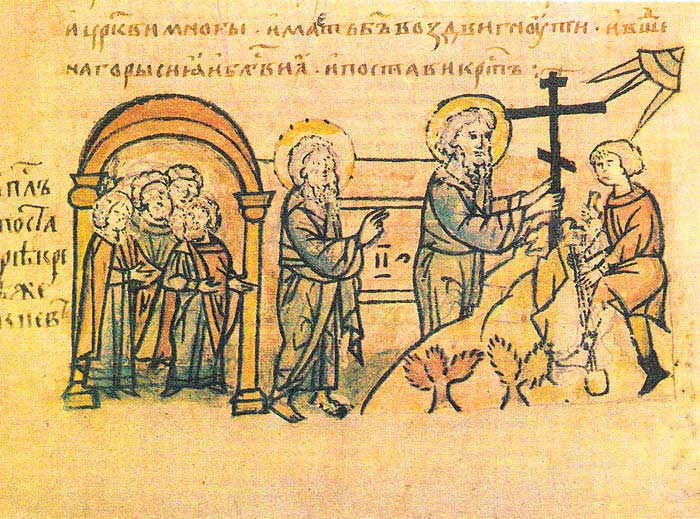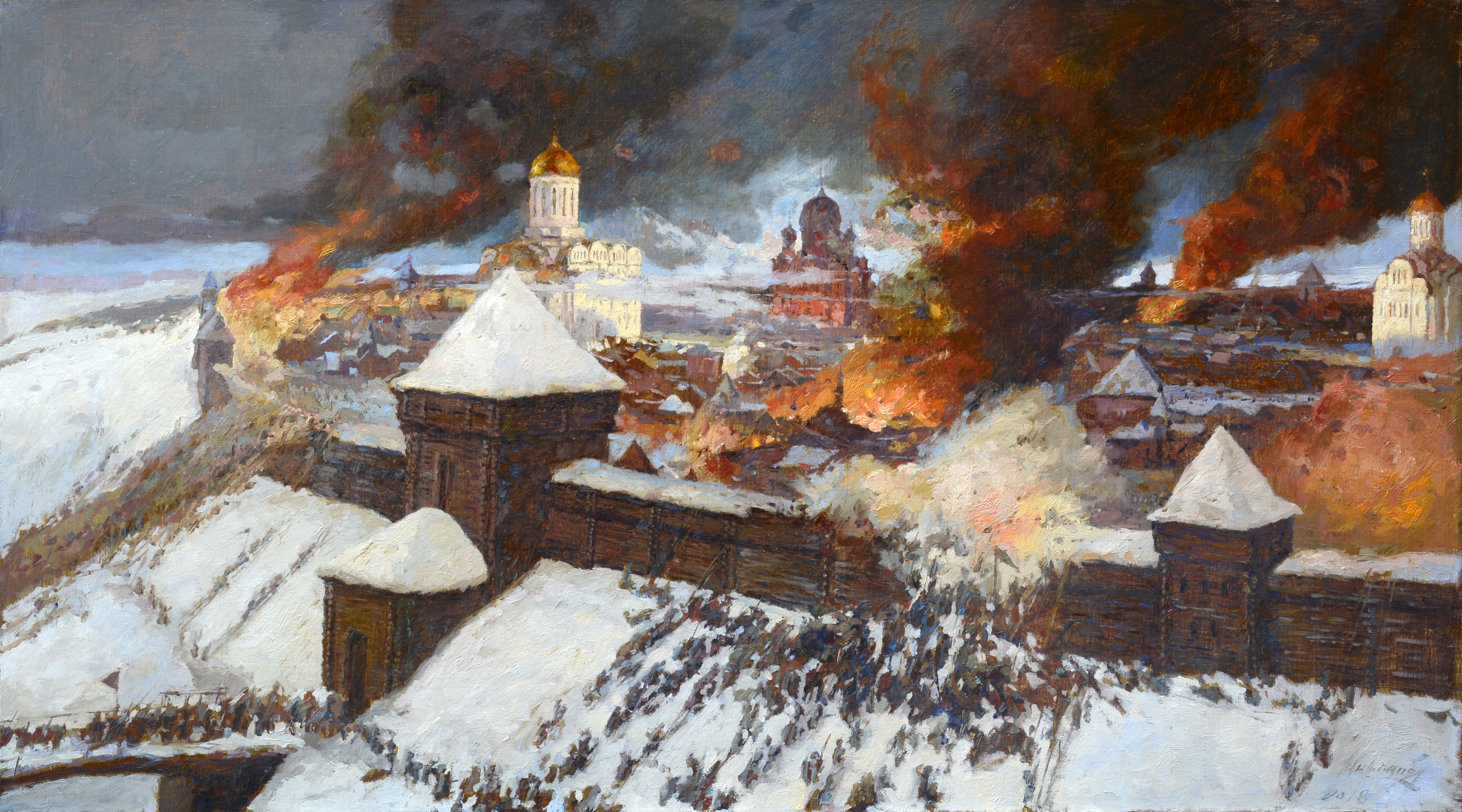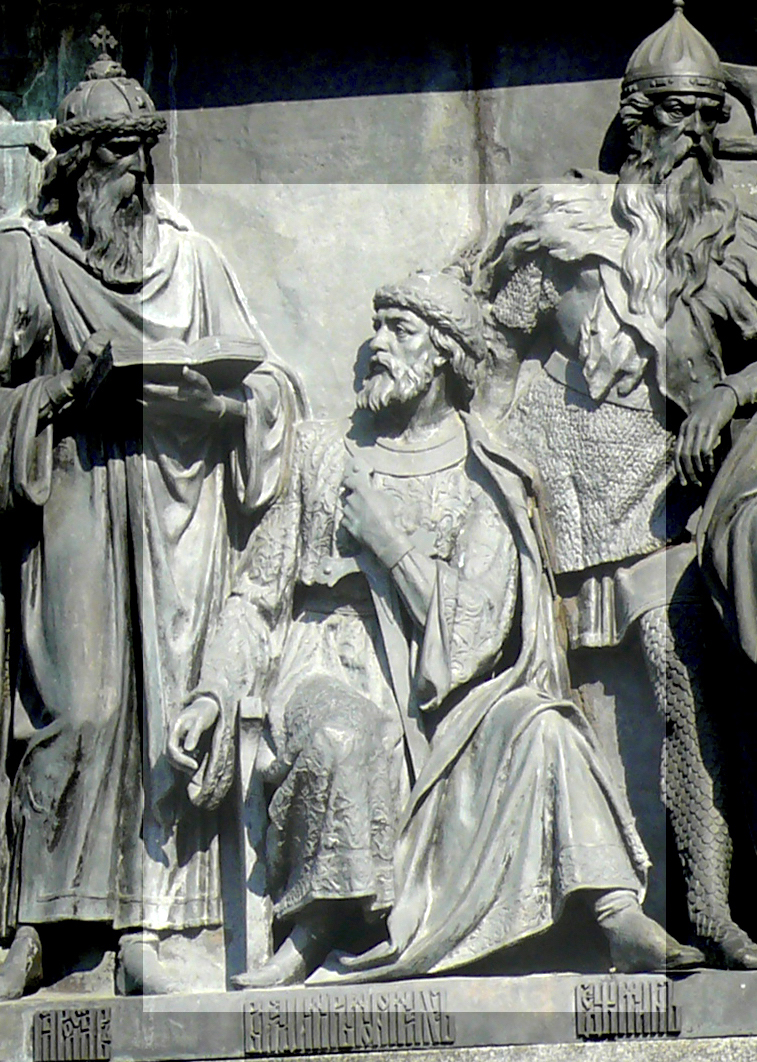|
St Andrew's Church, Kyiv
St Andrew's Church (, ''Andriivska tserkva'') is an Orthodox church in Kyiv, constructed between 1747 and 1754 to a design by the Italian architect Bartolomeo Rastrelli. It is a rare example of Elizabethan Baroque in Ukraine. Situated on a steep hill, where Andrew the Apostle is believed to have foretold the great future of the place as the cradle of Christianity in the Slavic lands, the church overlooks the historic Podil neighborhood. The building of St Andrew's Church is government-owned. In 1968, it was designated as a museum, part of the National Sanctuary "Sophia of Kyiv" as a landmark of cultural heritage. From 2008 to 2018, the Ukrainian Autocephalous Orthodox Church was allowed to use it as its mother church. In October 2018, in anticipation of the unification council of the Eastern Orthodox churches of Ukraine, the Ukrainian state decided instead to allow its direct use by the Ecumenical Patriarchate of Constantinople. At the beginning of the 21st century the buildi ... [...More Info...] [...Related Items...] OR: [Wikipedia] [Google] [Baidu] |
Andriyivskyy Descent
Andriivskyi Descent or Andrew's Descent (, ) is a historic descent connecting Kyiv's Upper Town neighborhood and the historically commercial Podil neighborhood. The street, often advertised by tour guides and operators as the "Montmartre of Kyiv", is a major tourist attraction of the city. It is included in the list of national landmarks by a government resolution. In addition, the street is also part of the Kyiv city historic reserve " Ancient Kyiv", while the St. Andrew's Church belongs to the National historic reserve " Sophia of Kyiv". The descent, in length, is constructed of laid cobblestones and connects Old Kyiv (Upper city) with Podil (Lower city). It starts at the end of Volodymyrska Street and winds down steeply around the Zamkova Hora hill, ending near the Kontraktova Square. Andrew's Descent is marked by some historic landmarks, including the Castle of Richard the Lionheart, the 18th century baroque Saint Andrew's Church, famed Russian writer Mikhail Bulgakov ... [...More Info...] [...Related Items...] OR: [Wikipedia] [Google] [Baidu] |
Unification Council Of The Eastern Orthodox Churches Of Ukraine
The Unification council of the Eastern Orthodox churches of Ukraine () is a council which was held on 15 December 2018 in the St Sophia's Cathedral in Kyiv. The council voted to unite the existing Ukrainian Eastern Orthodox churches (the UOC-KP, the UAOC and parts of the UOC-MP) through their representatives, on the basis of complete canonical independence. All the members of the UOC-KP and the UAOC, and two members of the UOC-MP, merged into the Orthodox Church of Ukraine and the unification council elected Epiphanius I as its first primate. History Three Eastern Orthodox churches in Ukraine Since the end of the 20th century, three Eastern Orthodox jurisdictions have existed in Ukraine. * The Ukrainian Orthodox Church (Moscow Patriarchate) (UOC-MP) which is part of the Russian Orthodox Church and thus under the Moscow Patriarchate. This church was, until 11 October 2018, the only Orthodox church in Ukraine recognized by other Orthodox churches. * The Ukrainian Auto ... [...More Info...] [...Related Items...] OR: [Wikipedia] [Google] [Baidu] |
Kievan Rus'
Kievan Rus', also known as Kyivan Rus,. * was the first East Slavs, East Slavic state and later an amalgam of principalities in Eastern Europe from the late 9th to the mid-13th century.John Channon & Robert Hudson, ''Penguin Historical Atlas of Russia'' (Penguin, 1995), p.14–16. Encompassing a variety of polities and peoples, including East Slavs, East Slavic, Norsemen, Norse, and Finnic peoples, Finnic, it was ruled by the Rurik dynasty, founded by the Varangians, Varangian prince Rurik.Kievan Rus , Encyclopædia Britannica Online. The name was coined by Russian historians in the 19th century to describe the period when Kiev was preeminent. At its greatest extent in the mid-11th century, Kievan Rus' stretched from the White Sea in the north to the Black Sea in the south and from the River source, headwaters of the ... [...More Info...] [...Related Items...] OR: [Wikipedia] [Google] [Baidu] |
Mongol Invasion Of Rus'
The Mongol Empire invaded and conquered much of Kievan Rus' in the mid-13th century, sacking numerous cities such as Principality of Ryazan, Ryazan, Principality of Yaroslavl, Yaroslavl, Principality of Pereyaslavl, Pereyaslavl and Vladimir-Suzdal, Vladimir, including the largest: Grand Principality of Kiev, Kiev (50,000 inhabitants) and Principality of Chernigov, Chernigov (30,000 inhabitants). The Siege of Kiev (1240), siege of Kiev in 1240 by the Mongols is generally held to mark the end of the state of Kievan Rus', which had already been undergoing Feudal fragmentation, fragmentation. Many other principalities and urban centres in the northwest and southwest escaped complete destruction or suffered little to no damage from the Mongol invasion, including Kingdom of Galicia–Volhynia, Galicia–Volhynia, Pskov Land, Pskov, Principality of Smolensk, Smolensk, Principality of Polotsk, Polotsk, Principality of Vitebsk, Vitebsk, and probably Vladimir-Suzdal, Rostov and Uglic ... [...More Info...] [...Related Items...] OR: [Wikipedia] [Google] [Baidu] |
Halych
Halych (, ; ; ; ; , ''Halitsch'' or ''Galitsch''; ) is a historic List of cities in Ukraine, city on the Dniester River in western Ukraine. The city gave its name to the Principality of Halych, the historic province of Galicia (Eastern Europe), Galicia (Halychyna), and the Kingdom of Galicia–Volhynia, of which it was the capital until the early 14th century, when the seat of the local rulers moved to Lviv. Nowadays, Halych is a small town located only on one part of the territory of the former Galician capital, although it has preserved its name. It belongs to Ivano-Frankivsk Raion (Administrative divisions of Ukraine, district) of Ivano-Frankivsk Oblast (Administrative divisions of Ukraine, region). It hosts the administration of Halych urban hromada, one of the hromadas of Ukraine. Halych lies north of the oblast capital, Ivano-Frankivsk. Population: Name The city's name, though spelled identically in modern East Slavic languages (Галич), is pronounced ''Halych'' in ... [...More Info...] [...Related Items...] OR: [Wikipedia] [Google] [Baidu] |
Vsevolod I Of Kiev
Vsevolod I Yaroslavich (; – 13 April 1093) was Grand Prince of Kiev from 1078 until his death in 1093. Early life He was the fifth and favourite son of Yaroslav I the Wise by Ingigerd Olafsdottir. He was born around 1030. On his seal from his last years, he was named "Andrei Vsevolodu" in Greek, implying that his baptismal name was Andrew. To back up an armistice signed with the Byzantine Emperor Constantine IX Monomachos in 1046, his father married Vsevolod to a Byzantine princess, who according to tradition was named Anastasia or Maria. That the couple's son Vladimir Monomakh bore the family name of the Byzantine emperor suggests she was a member of his close family, but no contemporary evidence attests to a specific relationship and accounts of the Emperor give him no such daughter. Upon his father's death in 1054, he received in appanage the towns of Pereyaslav, Rostov, Suzdal, and the township of Beloozero which would remain in possession of his descendants ... [...More Info...] [...Related Items...] OR: [Wikipedia] [Google] [Baidu] |
Grand Prince Of Kiev
The Grand Prince of Kiev (sometimes also Grand Duke) was the title of the monarch of Kievan Rus', residing in Kiev (modern Kyiv) from the 10th to 13th centuries. In the 13th century, Kiev became an appanage principality first of the grand prince of Vladimir and the Mongol Golden Horde governors, and later was taken over by the Grand Duchy of Lithuania. Rus' chronicles such as the ''Primary Chronicle'' are inconsistent in applying the title "grand prince" to various princes in Kievan Rus'. Although most sources consistently attribute it to the prince of Kiev, there is no agreement which princes were also "grand prince", and scholars have thus come up with different lists of grand princes of Kiev. Background Origins According to a founding myth in the ''Primary Chronicle'', Kyi, Shchek and Khoryv and their sister Lybid co-founded the city of Kiev (Kyiv), and the oldest brother Kyi was "chief of his kin" (). Some western historians (i.e., Kevin Alan Brook) suppose that Kie ... [...More Info...] [...Related Items...] OR: [Wikipedia] [Google] [Baidu] |
History Of Christianity In Ukraine
The history of Christianity in Ukraine dates back to the earliest centuries of the history of Christianity, to the Apostolic Age, with mission trips along the Black Sea and a legend of Andrew the Apostle even ascending the hills of Kiev. The first Christian community on territory of modern Ukraine is documented as early as the 4th century with the establishment of the Metropolitanate of Gothia, which was centered in the Crimean peninsula. However, on territory of the Old Rus in Kiev, Christianity became the dominant religion since its official acceptance in 989 by Vladimir the Great (Volodymyr the Great), who brought it from Byzantine Crimea and installed it as the state religion of medieval Kievan Rus (Ruthenia), with the metropolitan see in Kiev. Although separated into various Christian denominations, most Ukrainian Christians share a common faith based on Eastern Christianity. This tradition is represented in Ukraine by the Byzantine Rite, the Eastern Orthodox and Eastern ... [...More Info...] [...Related Items...] OR: [Wikipedia] [Google] [Baidu] |
Dnipro River
The Dnieper or Dnepr ( ), also called Dnipro ( ), is one of the major transboundary rivers of Europe, rising in the Valdai Hills near Smolensk, Russia, before flowing through Belarus and Ukraine to the Black Sea. Approximately long, with a drainage basin of , it is the longest river of Ukraine and Belarus and the fourth- longest river in Europe, after the Volga, Danube, and Ural rivers. In antiquity, the river was part of the Amber Road trade routes. During the Ruin in the later 17th century, the area was contested between the Polish–Lithuanian Commonwealth and Russia, dividing what is now Ukraine into areas described by its right and left banks. During the Soviet period, the river became noted for its major hydroelectric dams and large reservoirs. The 1986 Chernobyl disaster occurred on the Pripyat River, a tributary of the Dnieper, just upstream from its confluence with the Dnieper. The Dnieper is an important navigable waterway for the economy of Ukraine and is conne ... [...More Info...] [...Related Items...] OR: [Wikipedia] [Google] [Baidu] |
Primary Chronicle
The ''Primary Chronicle'', shortened from the common ''Russian Primary Chronicle'' (, commonly transcribed ''Povest' vremennykh let'' (PVL), ), is a Rus' chronicle, chronicle of Kievan Rus' from about 850 to 1110. It is believed to have been originally compiled in or near Kiev in the 1110s. Tradition ascribed its compilation to the monk Nestor the Chronicler, Nestor (''Nestor's Chronicle'') beginning in the 12th century, but this is no longer believed to have been the case. The title of the work, ("Tale of Bygone Years") comes from the opening sentence of the Laurentian Codex, ''Laurentian'' text: "These are the narratives of bygone years regarding the origin of the land of Rus', the first princes of Kiev, and from what source the land of Rus' had its beginning". The work is considered a fundamental source for the earliest history of the East Slavs. The content of the chronicle is known today from the several surviving versions and codices, revised over the years, slightly var ... [...More Info...] [...Related Items...] OR: [Wikipedia] [Google] [Baidu] |
Chronicle
A chronicle (, from Greek ''chroniká'', from , ''chrónos'' – "time") is a historical account of events arranged in chronological order, as in a timeline. Typically, equal weight is given for historically important events and local events, the purpose being the recording of events that occurred, seen from the perspective of the chronicler. A chronicle which traces world history is a universal chronicle. This is in contrast to a narrative or history, in which an author chooses events to interpret and analyze and excludes those the author does not consider important or relevant. The information sources for chronicles vary. Some are written from the chronicler's direct knowledge, others from witnesses or participants in events, still others are accounts passed down from generation to generation by oral tradition.Elisabeth M. C. Van Houts, ''Memory and Gender in Medieval Europe: 900–1200'' (Toronto; Buffalo: University of Toronto Press, 1999), pp. 19–20. Some used writ ... [...More Info...] [...Related Items...] OR: [Wikipedia] [Google] [Baidu] |
Encyclopedia Of Ukraine
The ''Encyclopedia of Ukraine'' (), published from 1984 to 2001, is a fundamental work of Ukrainian Studies. Development The work was created under the auspices of the Shevchenko Scientific Society in Europe (Sarcelles, near Paris). As the ''Encyclopedia of Ukrainian Studies'' it conditionally consists of two parts, the first being a general part that consists of a three volume reference work divided in to subjects or themes. The second part is a 10 volume encyclopedia with entries arranged alphabetically. The editor-in-chief of Volumes I and II (published in 1984 and 1988 respectively) was Volodymyr Kubijovyč. The concluding three volumes, with Danylo Husar Struk as editor-in-chief, appeared in 1993. The encyclopedia set came with a 30-page ''Map & Gazetteer of Ukraine'' compiled by Kubijovyč and Arkadii Zhukovsky. It contained a detailed fold-out map (scale 1:2,000,000). A final volume, ''Encyclopedia of Ukraine: Index and Errata'', containing only the index and a list ... [...More Info...] [...Related Items...] OR: [Wikipedia] [Google] [Baidu] |










